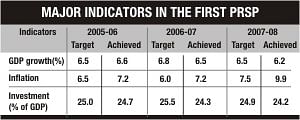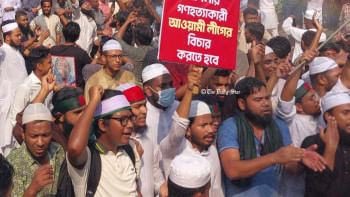2nd PRSP okayed with high investment target

The government has set an ambitious target for domestic investment in the second Poverty Reduction Strategy Papers (PRSP) approved yesterday while the investment slid in the past three fiscal years.
The PRSP II, titled “Moving Ahead: National Strategy for Accelerated Poverty Reduction II (NSAPR),” has set ambitious targets of 26.3 percent and 27 percent gross domestic investment out of the GDP for fiscal 2009-10 and 2010-11.
Gross domestic investment slipped to 24.2 percent in 2007-08 from 24.3 percent and 24.7 percent in 2006-07 and 2005-06.
The caretaker government approved the strategy at a meeting of the National Economic Council (NEC) chaired by Chief Adviser Fakhruddin Ahmed yesterday.
GDP growth has also been projected in the PRSP II at 7 percent and 7.2 percent for 2009-10 and 2010-11, higher than the projected 6.2 percent and 6.5 percent for 2007-08 and 2008-09.
The government however said the macroeconomic forecast has been made taking into account the uncertain global economic outlook and continued uncertainties in domestic developments.
“The forecast represents a cautiously optimistic scenario that is consistent with recent trends but also takes account of the impact of fiscal policy reforms,” it said.
According to the projection, total cost of implementing the second PRSP for the period 2009-2011 is estimated at Tk 3,190.44 billion, including a Tk 1,052 billion deficit financing.
Of the deficit, Tk 631 billion or over 60 percent would come from foreign assistance and the remaining Tk 421 billion from domestic borrowing, according to the projection.
Advisers to the caretaker government attended the NEC meeting.
The first PRSP was introduced for the period 2005--2007 and the time limit was extended up to the last fiscal year.
It was prepared mainly with advice from the International Monetary Fund (IMF) and World Bank.
But the government has not yet assessed the failures and successes of the first PRSP.
Talking to reporters after the NEC meeting yesterday, Finance Adviser AB Mirza Azizul Islam said, “We are an unelected government, but not a normal three-month caretaker one.”
Asked whether the elected government would own their decision or not, he said, “It is a matter of theirs."
Of the Tk 3,190.44 billion total expenditure projected for implementing the second PRSP, Tk 2,567.99 billion would be spent directly for implementing the goals of the PRSP II and the remaining Tk 622.45 billion for interest payment and defence expenditure.
The projected revenue earning has been set at Tk 2,138.45 billion while domestic borrowing would stand at Tk 421.05 billion.
Of the total estimated cost of implementing the PRSP, the highest 22.56 percent or Tk 579.34 billion would be for education, training and research followed by 20.64 percent or Tk 529.94 billion for infrastructure for pro-poor growth and 11.72 percent or 300.95 billion for promoting good governance and public services.
Some 3.32 percent or Tk 85.33 billion of the spending projected in the PRSP would be for food security.
The PRSP II says the government will extend the tax net and value added tax (VAT) to increase revenue earnings. It will introduce unified tax identification numbers (TIN) for income tax and VAT.
The government will also introduce public-private partnership for decentralising tax collection efforts.
The new PRSP also plans reduction of average protective tariff to 15 percent and enhancement of revenue mobilisation efforts for reducing dependence on import taxes.
To enhance private investment, the government will take measures to make unused land available for creating industrial or economic zones, provide incentives for private industrial estates, and will acquire land for handover to potential investors through the Board of Investment for setting up new industrial or special economic zones, or for industrial parks.
In the second PRSP, the government has also disclosed a plan for instituting new policies and regulatory frameworks to facilitate private investments in economic zones, and to improve land zoning for industrial purposes.
To attract foreign direct investment (FDI), the government will also introduce equity protection laws, and simplify procedures for opening up branches or liaison offices of foreign companies in Bangladesh.
Moreover, measures will be taken to reduce the use of chemical fertilisers and pesticides along with phasing out persistent organic pollutants.
The second PRSP has also planned to construct an elevated expressway in the capital and a Dhaka-Chittagong expressway by 2011 in a bid to ease traffic congestion in the capital and to speed up communication with the port city.
It also plans to upgrade Dhaka-Chittagong, Dhaka-Khulna, Dhaka-Sylhet and Dhaka-Tangail highways to four lanes, and to construct the already planned Padma Bridge by 2011.
The government strategy document for 2009-2011 also includes a plan to construct a ring road around the capital and a flyover across Pragati Sarani in Gulshan area.

 For all latest news, follow The Daily Star's Google News channel.
For all latest news, follow The Daily Star's Google News channel. 



Comments